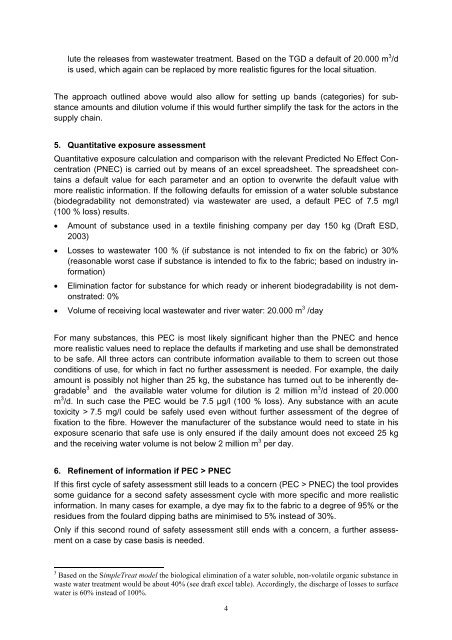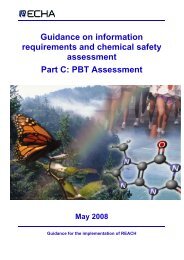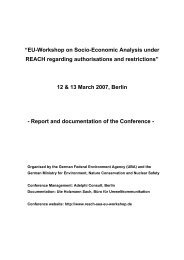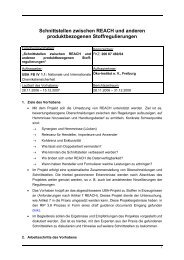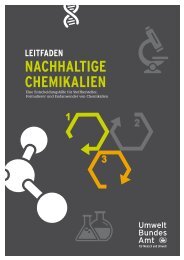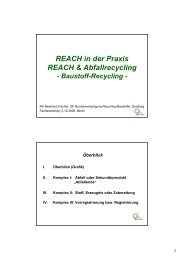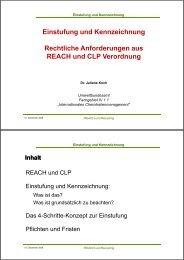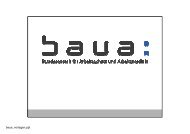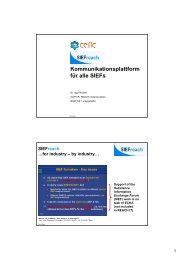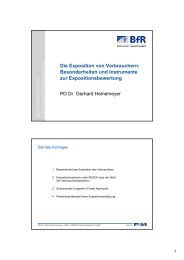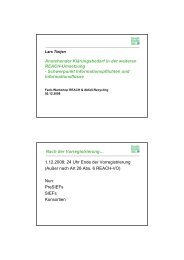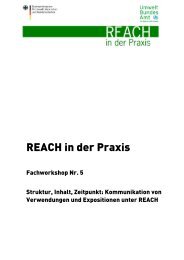Schlussbericht 2004-11-30 - REACh
Schlussbericht 2004-11-30 - REACh
Schlussbericht 2004-11-30 - REACh
Sie wollen auch ein ePaper? Erhöhen Sie die Reichweite Ihrer Titel.
YUMPU macht aus Druck-PDFs automatisch weboptimierte ePaper, die Google liebt.
lute the releases from wastewater treatment. Based on the TGD a default of 20.000 m 3 /d<br />
is used, which again can be replaced by more realistic figures for the local situation.<br />
The approach outlined above would also allow for setting up bands (categories) for substance<br />
amounts and dilution volume if this would further simplify the task for the actors in the<br />
supply chain.<br />
5. Quantitative exposure assessment<br />
Quantitative exposure calculation and comparison with the relevant Predicted No Effect Concentration<br />
(PNEC) is carried out by means of an excel spreadsheet. The spreadsheet contains<br />
a default value for each parameter and an option to overwrite the default value with<br />
more realistic information. If the following defaults for emission of a water soluble substance<br />
(biodegradability not demonstrated) via wastewater are used, a default PEC of 7.5 mg/l<br />
(100 % loss) results.<br />
• Amount of substance used in a textile finishing company per day 150 kg (Draft ESD,<br />
2003)<br />
• Losses to wastewater 100 % (if substance is not intended to fix on the fabric) or <strong>30</strong>%<br />
(reasonable worst case if substance is intended to fix to the fabric; based on industry information)<br />
• Elimination factor for substance for which ready or inherent biodegradability is not demonstrated:<br />
0%<br />
• Volume of receiving local wastewater and river water: 20.000 m 3 /day<br />
For many substances, this PEC is most likely significant higher than the PNEC and hence<br />
more realistic values need to replace the defaults if marketing and use shall be demonstrated<br />
to be safe. All three actors can contribute information available to them to screen out those<br />
conditions of use, for which in fact no further assessment is needed. For example, the daily<br />
amount is possibly not higher than 25 kg, the substance has turned out to be inherently degradable<br />
3 and the available water volume for dilution is 2 million m 3 /d instead of 20.000<br />
m 3 /d. In such case the PEC would be 7.5 µg/l (100 % loss). Any substance with an acute<br />
toxicity > 7.5 mg/l could be safely used even without further assessment of the degree of<br />
fixation to the fibre. However the manufacturer of the substance would need to state in his<br />
exposure scenario that safe use is only ensured if the daily amount does not exceed 25 kg<br />
and the receiving water volume is not below 2 million m 3 per day.<br />
6. Refinement of information if PEC > PNEC<br />
If this first cycle of safety assessment still leads to a concern (PEC > PNEC) the tool provides<br />
some guidance for a second safety assessment cycle with more specific and more realistic<br />
information. In many cases for example, a dye may fix to the fabric to a degree of 95% or the<br />
residues from the foulard dipping baths are minimised to 5% instead of <strong>30</strong>%.<br />
Only if this second round of safety assessment still ends with a concern, a further assessment<br />
on a case by case basis is needed.<br />
3 Based on the SimpleTreat model the biological elimination of a water soluble, non-volatile organic substance in<br />
waste water treatment would be about 40% (see draft excel table). Accordingly, the discharge of losses to surface<br />
water is 60% instead of 100%.<br />
4


